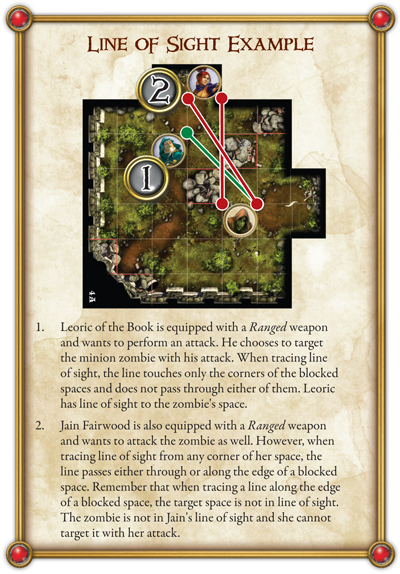Siguiendo con el ritual de ir mostrándonos en formato de pequeñas píldoras informativas, los chicos de FFG, nos informan hoy de como funcionara el tema de los dados, así como las mecánicas de línea de visión y alguna que otra imagen, para ir deleitándonos, con lo que nos ofrecerá, esta revisión del clásico Descent.
Además hoy, podremos descargarnos un PDF, con un ejemplo de combate.
Every passing week brings us that much closer to the release of Descent: Journeys in the Dark Second Edition! We’ve seen a great deal over the past month, including an overview of a hero’s turn, a look at the overlord and his minions, and an examination of the Warrior archetype.

But with rampaging ettins and axe-wielding berserkers competing for the fate of Terrinoth, it goes without saying that pacifism is out of the question. We’ve already seen that “Attack” is one of the most important actions a hero can choose on his turn (important enough, in fact, to often choose it twice), but how are attacks actually resolved? Today, we’ll look at Second Edition’s custom dice, we’ll discuss its new line of sight rules, and we’ll put it all together with a detailed example of an attack.
Seeking Fortune’s Favor
Second Edition features nine custom dice in six types, three of which are generally used for defense while the other three are most often used for offense.






Second Edition’s nine custom dice consist of one brown, two gray, and one black defense dice,
plus one blue attack die, and two red and two yellow power dice.
Click the above images to see each die’s full configuration.
|
Another symbol that the attack and power dice have in common is the surge (
All together, these versatile combat rules contribute to both tactical depth and character distinctiveness, as each hero and weapon setup offers engaging dice combinations along with compelling ways to spend surges. Will you stun your foe, or is raw damage the wiser approach? Should you force your opponent to reroll a defense die, or should you recover a fatigue in anticipation of an upcoming turn? With each attack comes a new wealth of interesting tactical possibilities.
Calling the Shots
As we discussed above, ranged attacks tend to require the blue attack die and at least one yellow power die, as it is these dice that provide range (a measure of how many spaces your attack can “travel” before hitting its target). The success of such attacks is not entirely a matter of distance, however. In order to target an enemy, an attacker must also have an unobstructed line of sight.

Veterans of first edition will notice an important difference in Second Edition’s line of sight rules. In short, rather than tracing “center to center” (from the center of the attacker’s space to the center of the target space), line of sight is now traced “corner to corner” (from any corner of the attacker’s space to any corner of the target space). Both corners are of the attacker’s choosing, but the line can neither cross over a blocked space nor be traced along its edge (see the example to the right). Daniel Clark, one of Second Edition’s developers, took a moment to explain this design decision:
It’s not that the first edition line of sight rules were confusing by any means, but they encouraged players to devote a lot of time to considering and executing the perfect shot. We would often see players paralyze the game as they deliberated line of sight, and it was this tendency that the design team wanted to minimize. By adopting more liberal line of sight requirements, we saw playtesters spending less time on these decisions and more time focused on the narrative.
While it’s difficult to convey the end result of this change in a preview, those who have played Second Edition can attest to a subtle shift in the combat dynamic. If attackers can more easily establish line of sight, it makes them less concerned with maneuvering for a clear shot. Conversely, however, their targets must now actively maneuver to take cover behind blocked spaces.
Tomble and the Zombie
Now that we’ve established the basics of combat, let’s put it all together with an example. First, however, meet Tomble Burrowell:

 To see how Tomble fares against the Master Zombie, download our combat example (pdf, 2.8 MB)!
To see how Tomble fares against the Master Zombie, download our combat example (pdf, 2.8 MB)!But what if things ultimately go poorly for Tomble? Should a hero suffer damage equal to or greater than his health, he is considered defeated and is knocked out. He then immediately suffers fatigue up to his total Stamina, and his controlling player removes his figure from the map and replaces it with one of his hero tokens (knocked out heroes block neither line of sight nor movement).
Unless a knocked out hero is revived by an adjacent ally, he can perform only one action on his turn, and that is to stand back up (to be clear, this constitutes a knocked out hero's entire turn). Such a hero rolls two red power dice, recovering damage equal to the
Reviving a knocked out ally follows the same basic procedure, but since a different hero is performing the action, it is a far more efficient use of everyone’s two actions per turn.
Ready to begin your own adventure? Keep checking back for more in the coming weeks, and look for Descent: Journeys in the Dark Second Edition and the Conversion Kit this summer!




















0 comentarios :
Dí lo que piensas...